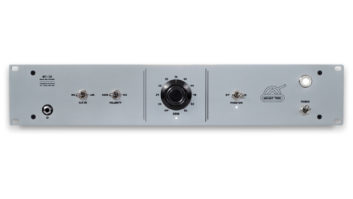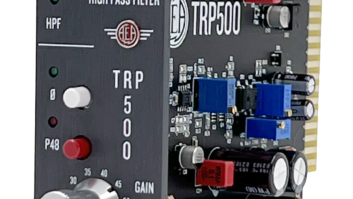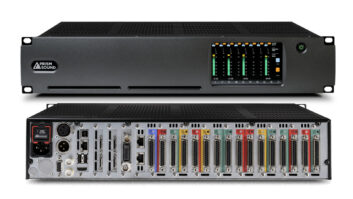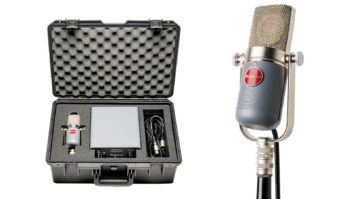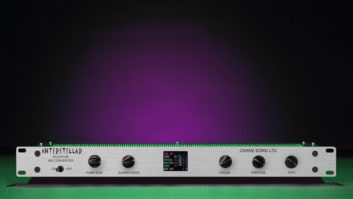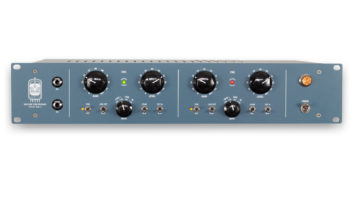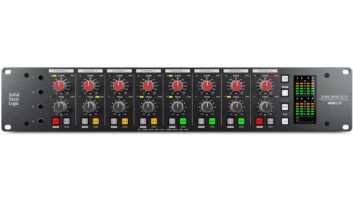There are lots of mic preamps on the market, and rather too many of them are “me-too” products that offer little more than repackages of standard cookbook designs based around the same chipsets. So when something really different comes along, I have to check it out. Priced at $2,495, the Aphex Model 1100 is a good example of something different.
Housed in a single-rackspace package, the 1100 is a work of art, both functionally and aesthetically. The layout is clean and straightforward, featuring a gloss midnight blue faceplate with chrome rack ears and recessed backlit panels for the meters and control switches. Each channel has its own rotary switches for gain (21 to 65 dB in 12 4dB steps) and low-cut filter; inset trimpot for precisely calibrating the line output; and push-buttons for -20dB pad, polarity, test tone, phantom power, channel mute, MicLim(tm) limiting and clock source for the onboard 24-bit 96kHz converters. on a glass panel behind each switch, are LEDs indicating the status of each control and a fast-acting 20-step LED headroom meter.
The rear panel has balanced (pin number 2 hot) XLRs for the mic inputs and line outs; 11/44-inch TRS line out jacks; XLR AES/EBU output, BNC word clock in/out and 11/44-inch jacks for external muting. outputs are switchable from +4dBu to -10dBV, and the internal power supply can be set for 100/120/220/240 volts. The top panel has vents for passively cooling the two tubes-users should avoid stacking the units tightly in a rack to avoid overheating.
Like the Model 107 preamp, the 1100 uses Aphex’s patented RPA(tm) (reflected plate amplifier) tube technology, but takes it one step further. A solid-state all-discrete, Class-A Bipolar PNP first stage is followed by a low-noise second stage op amp using a single triode RPA. The RPA Class-A impedance balanced output stage will run balanced or unbalanced lines with an output of up to +27 dBu. An automatic servo biasing feature allows users to swap out the stock (6-volt filament) 6N1P or 6DJ8 triodes for a variety of other tubes, including 12-volt tubes that are accommodated via an internal filament voltage switch. So there’s a wealth of alternate “plug-ins” available if users want to experiment with higher-distortion 12AX7/12AU7 tubes for a different sound.
I began working with the 1100 on a spoken-word session, recording two narrators speaking into E-V RE-20s directly to ProTools|24. The RE-20 is a fairly low-output mic, but, using the 1100, I could bump them way up without raising the noise floor, which would have been quite noticeable using the stock preamps on my vintage Soundcraft 600 board. I was impressed with the highpass filter, which offers a wide range of frequencies (12 steps from 30 to 195 Hz). The -2dB/octave slope was smooth, musical and unobtrusive and left no artifacts. And by removing low-end crud, the HP filter opens up more headroom for the signals you actually want. Sweet!
The 1100 includes lots of small, but nice touches, such as relay switching on the -20dB pad and phase reverse circuits, a phantom power switch that ramps up and down slowly, and a mute button that cuts both analog and digital outputs. The 700Hz (-20dB) tone generator requires a one-second press to avoid accidental switch-ons during sessions. A rear-panel switch jack enables remote muting, useful as a “cough” button.
Perhaps one of the 1100’s slickest features is MicLim(tm). Typically, I stay away from built-in limiters, but this one’s different. As opposed to the conventional slap-a-peak-limiter-in-after-the-preamp approach, the 1100 puts an optically-coupled attenuator before the preamp and drives it via a peak detector from the preamp output. The result takes the mic’s self-impedance into account and offers not only ultrasmooth limiting action, but due to a new, fast-acting photocell, excellent transient handling that traditional CdS photocells can’t match. And in most cases, having the limiter switched into the circuit was imperceptible, with the limiting action only audible in cases of extreme overload.
While recording piano direct to 2-track analog, I used a pair of very flat, ultra-low-noise Neumann TLM-103 cardioids feeding the 1100. The results were astonishing, providing an awesome sound that was natural, dynamic and absolutely free of noise. In fact, the level of detail so impressed the artist and clients that after the session, we recorded a rendition of the ending of The Beatles’ “A Day in the Life,” just to hear how far the chord could sustain before noise was apparent. We were still hearing low-level detail of the piano sustain well past a minute after the last chord. At that point, the limiting factor was the amps in the monitor chain, so I patched a set of Stax line-level electrostatic headphones to the 1100 outputs and the sustain kept continuing. Getting this level of performance from two $995 mics and a $2,495 preamp was impressive, and perhaps the 1100’s -135dB EIN spec may be a little on the conservative side.
It’s hard to get excited about mic preamps, but I just might make an exception in the case of the Aphex 1100. Anyone who deals with high-detail recording-certainly Foley recordists, ribbon mic fans and high-res analog or 24/96 digital users-will appreciate the unit’s low-noise performance, flexible feature set and, according to Page 2 of the manual, Y2K compliance. And its solid build should keep this one working until Y3K. Thumbs up.
Aphex Systems, 11068 Randall St., Sun Valley, CA 91352; 818/767-2929; www.aphex.com.
